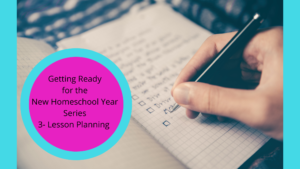Lesson Planning
Once I selected or put together curriculum, the next thing I do is lesson planning; or spreading out the lessons over the year.
When I started off years ago, I would very meticulously write down the page numbers of all topics to cover that day, into a book, under the respective days. But very soon I realized how cumbersome it is to have to change everything in case we miss one day. Over time I developed a new form of lesson planning which mostly involves just a one page checklist to be used over the whole year. I think it’s probably the most easiest form of lesson planning. Younger kids might need little help here and there, but works perfectly well with our older kids.

These are the steps I take to decide how much of each subject they need to cover in a day.
1)First I try to assess how many school weeks we will be having that year. Usually we do about 36 weeks a year, although we do some school over summer too. The summer school is not usually an extension of the school year curriculum. It is more so some baseline subjects I want them to do, or special subjects. So I don’t take into account the summer months. Some years, if we have planned an out-of-state or out-of-country trip, I take that into account while lesson planning. I also identify the subjects that year I want to do an ‘intensive’ on. For example, we have resorted to doing nature study more so as an intensive, than spread over the year. Sometimes we do a ‘geography intensive’, especially if that year we are able to participate in a Geography Bee competition. Sometimes I like a ‘writing intensive’ if I feel it will be beneficial that year. Or ‘science experiment intensive’, etc. By ‘intensive’, I mean taking the week off of regular school and concentrating only on that subject. I have found it to be a nice break and usually lots of learning happens during those weeks.
2) One of the next things I do is identify what all subjects can be taught together, either several kids together or the whole family.We have been doing history this way, in which all kids will learn the same topics, but at different levels. For such subjects, I make sure I plan out the lessons for each kid, that they proceed at the same pace.
3) I then identify all the ‘essential / core’ subjects I want them to try to tackle every day for sure. I also identify the ‘supplemental/ extra subjects’ that I am ok with skipping occasionally if other things pop up.
4) Next step will be to identify all the miscellaneous small things that I think will be beneficial to do as a family. As some homeschoolers call it, we call it ‘Power Hour’. This may include Bible verses, Saint of the Day, Hymn Study, Poems, Read Alouds, Geography Quizzes, short videos or documentaries, etc.
5) I then determine the number of lessons or pages that each subject has for that year. This can easily be figured from the index, or just browsing over the pages.
6) Next is to divide the lessons or page numbers over the number of weeks available. This will help me see how much to cover in a day. Now instead of what I used to do by writing down these numbers under a certain date, what I do now is basically develop a daily checklist where they can know how many pages to do each day or how many chapters to do each day or week. I also write the details of what they are expected to do. For example, under Science, I may write ‘1 lesson over the week. Write notes for the chapter. Review questions at the end. Take the quiz. ” This gives them a little freedom also to split the lesson over the week they wish to, as long as they cover all that is expected. This will enhance independence and time management skills, instead of dictating exact pages they need to do that particular day. I only need to followup and make sure they are doing all the items on the list.
I list it also under subheadings of ‘core subjects’ and ‘extra’ subjects. That way they start with the core subjects and work their way through the supplemental subjects.
For subjects that already come with a lesson plan, I attach that along, so that they can follow through. I urge them to follow the specific lesson plan for that subject.
If it looks too much to do in one day I rotate the supplemental subjects in a way that they don’t have to do all the subjects in one day. Some homeschoolers use the term ‘loop scheduling’ in which you do the basic core subjects for the day but then loop/rotate through the supplemental subjects, one or two a day.
I am including the daily lesson plan checklist of one of my kids for the coming year. I sometimes tweak things up a bit depending on the semester, or depending on how well it’s going. For example, if I see that all the core subjects listed are hard to finish every day, I put some of them in the supplemental list, and then rotate them. Also, if there is any sporadic, special assignments or competitions they need to prepare for, I tweak accordingly. The checklist is thus not ‘set in stone’. You can modify it to suit the current situation, with a just a few minor edits.

For the subjects that I teach as family or group, I will list out around what time I expect to cover those. The rest of the subjects, I don’t really mind whichever order they cover. That way, it gives them independence in ordering their day, and managing their time.
This is one of the most easiest ways of lesson planning where the kids know exactly what to do each day by just looking at that one sheet every day! You don’t need to spend lots of time writing out plans, each week. Just put it in a sheet protector, and they can reuse it every day using a dry-erase marker!
My Daily Checklist
As I had mentioned in a previous post (3 useful Back to Homeschool Tips), I also make a daily checklist for myself, so that I remember what all I need to do from my end each day to make everything happen, including teaching, preparing, printing, etc.
With our current homeschool system, The kids have only 3 main folders, for all the subjects combined (instead of a separate folder or notebook for each subject, except for some programs that require a separate folder).
Lesson Plan folder
Each of the kids have their own lesson plan folder where I put this daily lesson plan checklist and other specific lesson plans for each subject. I put the lesson plan checklist in a sheet protector so that they can use their markers to check it and reuse. I also put together in this folder, other relevant material such as spelling word lists, vocabulary lists, writing templates/ rubrics, a list of writing prompts to use if bored, any mathematical formulas/concepts, list of Bible verses for the year, any experiment lists, or any other information they might need for the year, that is good to have in one place, organized by subject.
Working Folder
They each have a working folder, in which they keep all the worksheets for the week that I put out. Whatever work they do that week they keep in that folder. When they are done with the work, they move the finished work to the back of the folder. When the folder starts getting full, I dump the work done into the ‘work done box’ that I have on top of my teacher desk, that I mentioned in a previous post.
Notes Folder
I recently started a ‘Notes folder’ instead of having separate folders/notebooks for each subject. I organize this by subject with divider tabs, so that they can keep all their notes in one place. I like using folders with detachable paper over notebooks, so that even if they make a mistake or want to change their notes, they don’t feel discouraged. They can just tear off the old one and replace with the new sheets.
In my next post, I will elaborate on Homeschool Organization.
Check out the other posts in this series, as well as previous relevant posts:
Getting Ready for the New School Year Series 1- Planning Curriculum
Getting Ready for the New School Year Series 2- Homeschool Room Clean out
Getting Ready for the New School Year Series 3- Lesson Planning
Getting Ready for the New School Year Series 4- Setting up a Homeschool Organization System
Deciding if Homeschooling is Right for you and a Basic Roadmap for Getting Started
A look at the Different Homeschool Methods and Educational Philosophies

Pingback: Getting Ready for the New Homeschool Year Series - 1 Curriculum Planning - Efficient Living With Grace From Above
Pingback: Getting Ready for the New Homeschool Year Series - 2 Homeschool Room Cleanout - Efficient Living With Grace From Above
Pingback: Getting Ready for the New Homeschool Year Series- 4 Setting up a Homeschool Organization System - Efficient Living With Grace From Above